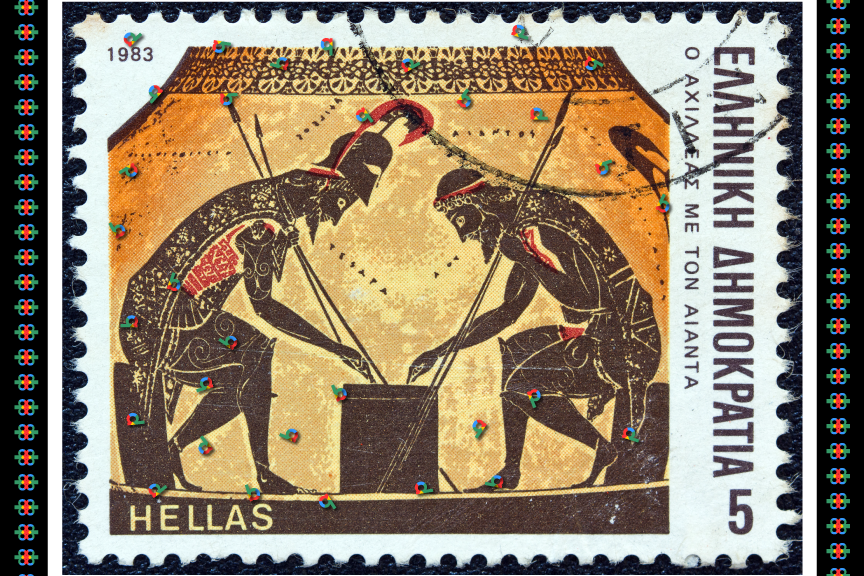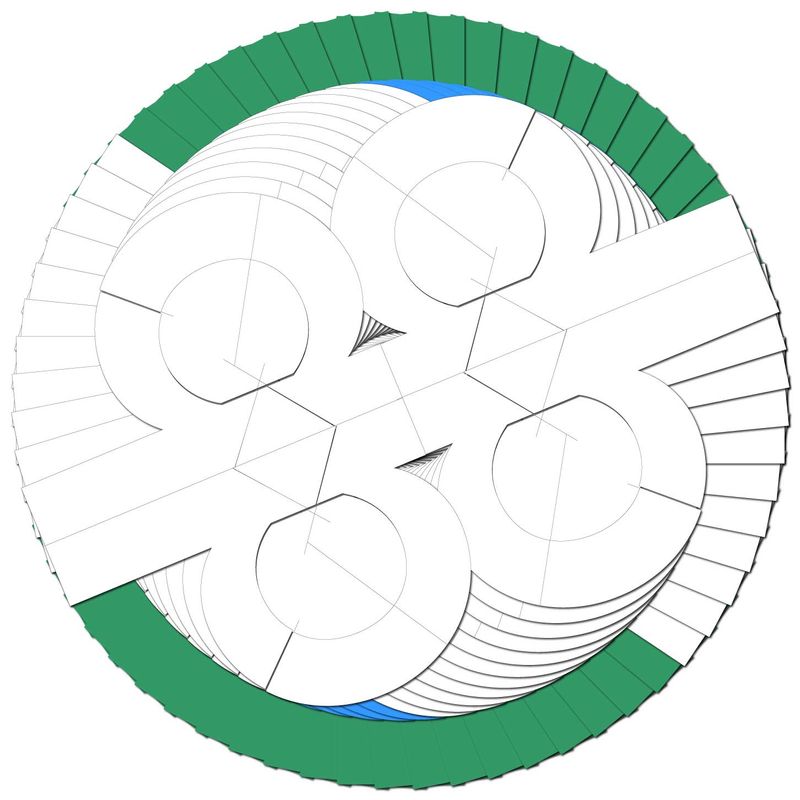Forever the Romantic Remembrancer

Atey Ate Mate
In a quaint town nestled between the undulating hills and ancient woodlands, an art installation captivated the community's collective imagination. A wheel reminiscent of a Möbius strip spun gracefully, its intricate design forming the number 88. Upon closer inspection, the wheel revealed itself as a dance of letters—p, q, b, and d—intertwined in an enigmatic union. It was a visual riddle, an artistry that seemed to convey the perpetual nature of life's cycle.
The mastermind behind this mesmerizing creation was a mysterious artist known only as Atey Ate Mate. Enchanted by the ever-spinning letters, the townspeople discerned a consistent theme as they gazed upon the wheel: Atey Ate Mate was the Fate of Eight. It was a rhythmic mantra that echoed through their minds, a silent chant that seemed to connect the disparate elements of the installation.
As the sun dipped below the horizon, casting hues of pink and orange across the sky, the townspeople gathered around the installation. It was a momentous night, and the air buzzed with anticipation. A sage, an elder who had spent a lifetime contemplating the mysteries of existence, stepped forward, commanding the crowd's attention.
Remember tonight... for it is the beginning of always.
— Dante Alighieri (1265-1321)
Initially captivated by poetic mysticism, the crowd shifted focus to the physicist's analytical approach. Thornton's attempt to understand the wheel's mechanics bridged the gap between art and science. Once a symbol of mystery, the installation transformed into a canvas for the convergence of different perspectives.
As Thornton explored, the physicist's demeanour changed. The precision of scientific analysis gave way to a contemplative appreciation for the wheel's design. The Möbius-like installation, responsive to his touch, revealed nuances, inviting him to embrace the mystery rather than solely dissect it.
In this convergence of wisdom and inquiry, the townspeople witnessed a dialogue between the sage's poetry and the physicist's analysis. The Möbius-like wheel, caught between realms, symbolized unity between the known and unknown.
The night, a space for shared exploration, deepened in its embrace. The Möbius-like wheel, a silent observer, became a testament to the limitless potential of human understanding. The convergence of timeless words, scientific scrutiny, and collective gaze transformed the town square into a crucible of discovery.
As the night continued, the Möbius-like wheel maintained its perpetual dance. It stood as a living testament to the interconnectedness of all things, where the mystical and scientific coexisted in the symphony of a night, marking not just a beginning but a continuum of always.
Everybody continues in its state of rest or of uniform motion in a right line unless it is compelled to change that state by forces impressed upon it.
— Issac Newton (1643-1727)
Thornton focused on Newtonian principles, approaching the wheel with a measured curiosity. His fingers brushed the cool metal, a tangible connection to the enigmatic Möbius-like installation. The crowd, attentive, observed as the wheel responded, letters rearranging themselves in intricate patterns. The convergence of the mystical and the scientific unfolded before their eyes.
Thornton's analytical demeanour softened in the face of this unexpected dance of letters. The complexity of the installation became apparent, a canvas for a dialogue between artistic expression and scientific scrutiny. The physicist, typically grounded in the laws of physics, found himself appreciating the intricate patterns as they formed, acknowledging a beauty beyond the realm of equations and theories.
The Möbius-like wheel's dance continued an eloquent response to sage and scientist alike. The town square, bathed in the soft glow of moonlight, became a theatre for the unfolding dialogue between timeless wisdom and scientific inquiry. In this convergence, the wheel transformed into a testament to the interconnectedness of all things—a visual representation of the interplay between the known and the unknown.
Humbled by the mysteries, Thornton stood in silent contemplation. His scientific mind grappled with the forces impressed upon the wheel and those hidden in the intricate dance of letters. The Möbius-like installation, once a mere curiosity, now stood as a reminder of the limits of understanding and the boundless potential for discovery.
The townspeople, witnesses to this transformative night, carried the memory with them. The Möbius-like wheel, bathed in the moonlit glow, marked not just a beginning but a continuum of always—a perpetual dance of exploration and revelation. The convergence of scientific inquiry and artistic expression left an indelible impression on the town square, a space now imbued with the energy of shared discovery.
As the night deepened, Thornton remained in contemplation, his scientific mind forever marked by the enigmatic dance he had witnessed. The townspeople, dispersing into the night, carried with them the memory of the Möbius-like wheel and the profound realization that within the intersection of art and science, there existed a rich tapestry of understanding waiting to be explored.
The Möbius-like wheel, with its perpetual dance and intricate patterns, stood as a silent beacon in the town square—a symbol of the enduring dialogue between the known and the unknown, the scientific and the mystical. And as the moon cast its gentle light upon the square, the town embraced the promise of a continuum, a journey marked by the ceaseless exploration of the mysteries that unfolded within and beyond the intricacies of the Möbius-like wheel.
Perhaps this art is a testament to the forces that shape our destinies, the invisible hands that guide us through the wheel of life.
— Anonymous
Thornton focused on Newtonian principles and approached the wheel, touching its cool metal. The crowd watched as the installation responded, rearranging its letters in intricate patterns. The convergence of the mystical and the scientific unfolded. Thornton's analytical demeanour softened, appreciating the complexity of the installation.
As scholars debated the physics, a compassionate activist in the crowd pondered the social implications of the art. "Perhaps this art is a testament to the forces that shape our destinies, the invisible hands that guide us through the wheel of life," she mused. Her gaze shifted from the intricate letters to the diverse faces in the crowd, recognizing the interconnectedness of individual destinies within the larger tapestry of societal forces.
The Möbius-like wheel, now a stage for scientific inquiry and social contemplation, seemed to respond to the activist's reflection. Its letters rearranged, forming patterns that hinted at the complexities of human connection and the influence of societal structures on individual paths.
The town square became a microcosm of thought and emotion in debates and reflections. The Möbius-like wheel, a silent witness, carried the weight of diverse perspectives. Sensing the potential for positive change, the compassionate activist stepped forward, addressing the crowd with a call for empathy and justice.
As the night deepened, the Möbius-like wheel continued its perpetual dance, capturing the essence of both scientific inquiry and social consciousness. The town square, now alive with the energy of diverse ideas, stood as a testament to the power of art to inspire reflection and dialogue across different spheres of understanding.
The Möbius-like wheel became a canvas for converging scientific thought and social awareness in this expanded scene. The crowd, now engaged in a multidimensional discourse, carried the resonance of this transformative night. This night marked not just a beginning but a continuum of always, where the forces shaping destinies were both seen and unseen, scientific and societal.
If the misery of the poor be caused not by the laws of nature but by our institutions, great is our sin.
— Charles Darwin (1809-1882)
The sage's words lingered in the night air as the crowd absorbed Dante's wisdom. The Möbius-like wheel continued its dance, drawing the attention of scholars, including physicist Professor Elias Thornton. He referenced Newton's law, emphasizing the persistent motion of objects unless external forces acted upon them while observing the wheel's perpetual motion.
Thornton, guided by Newtonian principles, approached the wheel, running his hand along its cool metal surface. The installation responded, rearranging its letters in intricate patterns. The convergence of mystical aesthetics and scientific inquiry unfolded, and Thornton's typically analytical demeanour softened as he appreciated the complex interplay before him.
As scholars debated the physics, a compassionate activist in the crowd contemplated the social implications of the art. Perhaps this art is a testament to the forces that shape our destinies, the invisible hands that guide us through the wheel of life, she suggested. Her gaze shifted from the installation to the diverse faces in the crowd, recognizing the interconnectedness of individual destinies within the larger societal framework.
The Möbius-like wheel, now a platform for scientific investigation and social contemplation, seemed to respond to the activist's insights. Its letters rearranged, forming patterns that hinted at the complexities of human connection and the influence of societal structures on individual paths.
Amidst debates and reflections, the town square became a microcosm of thought and emotion. The Möbius-like wheel, a silent witness, carried the weight of diverse perspectives. Sensing the potential for positive change, the compassionate activist stepped forward, addressing the crowd with a call for empathy and justice.
The notion that the misery of the poor be caused not by the laws of nature but by our institutions resonated in the collective consciousness. The Möbius-like wheel, in its silent eloquence, seemed to acknowledge this truth. The letters rearranged themselves, forming new patterns that spoke of empathy, justice, and the potential for positive change. It was as if the installation responded to the community's shared aspirations.
Amidst philosophical musings and intellectual debates, a quiet writer observed the scene, inspired by the profound artistry before her. The writer, capturing the essence of the evolving narrative, sensed the transformative power of the Möbius-like wheel as it became a catalyst for introspection and a canvas for the expression of collective ideals. Now a crucible of diverse thoughts and emotions, the town square stood as a testament to the potential for positive change, where art, science, and societal reflection converged in a silent symphony of possibility.
A book must be the axe for the frozen sea within us.
— Franz Kafka (1883-1924)
Her words resonated with those present, emphasizing the ability of art to break through the barriers of complacency and indifference. The short story of Atey Ate Mate, the Möbius-like wheel, and the profound quotes became a testament to the power of art to transcend boundaries and inspire change.
The sage, the physicist, the activist, and the writer found themselves in a collaborative dance, each contributing a unique thread to the evolving narrative of the town. The Möbius-like wheel, with its ceaseless spin, became a symbol of interconnected lives, a visual representation of the threads that wove together the fabric of existence.
As the night unfolded, the collaborative spirit deepened. The sage's words resonated with ancient wisdom, offering a timeless perspective. The physicist's analytical gaze met the activist's call for societal change, bridging scientific inquiry and compassionate action. Inspired by the unfolding spectacle, the writer captured the essence of the diverse perspectives, weaving them into a tapestry of words.
Little did the townspeople know, the short story of that transformative night would extend beyond their community, capturing the hearts and minds of those who yearned for meaning and connection in a world filled with enigma and possibility. The Möbius-like wheel, with its mysterious dance of letters, transcended the confines of the town square.
The installation became a beacon of inspiration, inviting travellers from far and wide to ponder the profound truths embedded in its intricate design—word of the collaborative dance spread, drawing seekers of wisdom and connection to the town. Visitors marvelled at the Möbius-like wheel, its letters forming patterns that spoke a universal language of shared humanity.
Once a quiet corner on the map, the town became a destination for those searching for something more. In this place, the convergence of sage advice, scientific exploration, social awareness, and artistic expression created a harmonious narrative. The collaborative dance, initiated by the Möbius-like wheel, continued to unfold, resonating far beyond the night that marked its inception.
The town's story became a living testament to the transformative power of collective exploration and shared understanding. The Möbius-like wheel, ever in motion, stood as a reminder that the journey of discovery was ongoing, a perpetual dance of learning and connection.
As the story spread, communities far and wide embraced the idea that within the seemingly endless enigma of life existed threads of meaning waiting to be unravelled. The Möbius-like wheel, with its intricate dance, served as a reminder that, like the letters in its perpetual spin, the possibilities for connection, understanding, and inspiration were boundless.
And so, the collaborative dance initiated in that small town square echoed through the hearts and minds of all who encountered the Möbius-like wheel. In its mysterious patterns, they found a story of a single night and a timeless invitation to explore the interwoven tapestry of existence—one that extended beyond the limits of the visible and beckoned each observer to become part of the ongoing dance of discovery.
And so, the town's story unfolded like the wheel's eternal spin, each letter representing a unique thread in our shared existence. The Möbius-like wheel, with its cryptic dance, spoke of the perpetual nature of change and the interconnectedness of all things. Ultimately, it wasn't merely an art installation but a living testament to the power of collective contemplation and the potential for profound transformation.
Never think you've seen the last of anything.
— Eudora Welty (1909-2001)
The sage's words lingered in the night air as the crowd absorbed Dante's wisdom. The Möbius-like wheel continued its dance, drawing the attention of scholars, including physicist Professor Elias Thornton. He referenced Newton's law, emphasizing the persistent motion of objects unless external forces acted upon them while observing the wheel's perpetual motion.
Thornton, guided by Newtonian principles, approached the wheel, running his hand along its cool metal surface. The installation responded, rearranging its letters in intricate patterns. The convergence of mystical aesthetics and scientific inquiry unfolded, and Thornton's typically analytical demeanour softened as he appreciated the complex interplay before him.
As scholars debated the physics, a compassionate activist in the crowd contemplated the social implications of the art. "Perhaps this art is a testament to the forces that shape our destinies, the invisible hands that guide us through the wheel of life," she suggested. Her gaze shifted from the installation to the diverse faces in the crowd, recognizing the interconnectedness of individual destinies within the larger societal framework.
The Möbius-like wheel, now a platform for scientific investigation and social contemplation, seemed to respond to the activist's insights. Its letters rearranged, forming patterns that hinted at the complexities of human connection and the influence of societal structures on individual paths.
Amidst debates and reflections, the town square became a microcosm of thought and emotion. The Möbius-like wheel, a silent witness, carried the weight of diverse perspectives. Sensing the potential for positive change, the compassionate activist stepped forward, addressing the crowd with a call for empathy and justice.
The notion that the misery of the poor be caused not by the laws of nature but by our institutions resonated in the collective consciousness. The Möbius-like wheel, in its silent eloquence, seemed to acknowledge this truth. The letters rearranged themselves, forming new patterns that spoke of empathy, justice, and the potential for positive change. It was as if the installation responded to the community's shared aspirations.
Amidst philosophical musings and intellectual debates, a quiet writer observed the scene, inspired by the profound artistry before her. The writer, capturing the essence of the evolving narrative, sensed the transformative power of the Möbius-like wheel as it became a catalyst for introspection and a canvas for the expression of collective ideals. Now a crucible of diverse thoughts and emotions, the town square stood as a testament to the potential for positive change, where art, science, and societal reflection converged in a silent symphony of possibility.
The Möbius-like wheel, a symbol of perpetual motion and change, seemed to embrace Welty's wisdom. Its letters continued their dance, creating patterns that spoke not only of the present but also hinted at the endless possibilities awaiting discovery in the future. The town square, now under the spell of Welty's reminder, brimmed with anticipation, as if each observer could glimpse the endless potential woven into the fabric of the evolving night.

The planksip Writers' Cooperative is proud to sponsor an exciting article rewriting competition where you can win over $750,000 in prize money.
Figures of Speech Collection Personified
Our editorial instructions for your contest submission are simple: incorporate the quotes and imagery from the above article into your submission.
What emerges is entirely up to you!
Winners receive $500 per winning entry multiplied by the article's featured quotes. Our largest prize is $8,000 for rewriting the following article;

At planksip, we believe in changing the way people engage; at least, that's the Idea (ἰδέα). By becoming a member of our thought-provoking community, you'll have the chance to win incredible prizes and access our extensive network of media outlets that will amplify your voice as a thought leader. Your membership truly matters!


